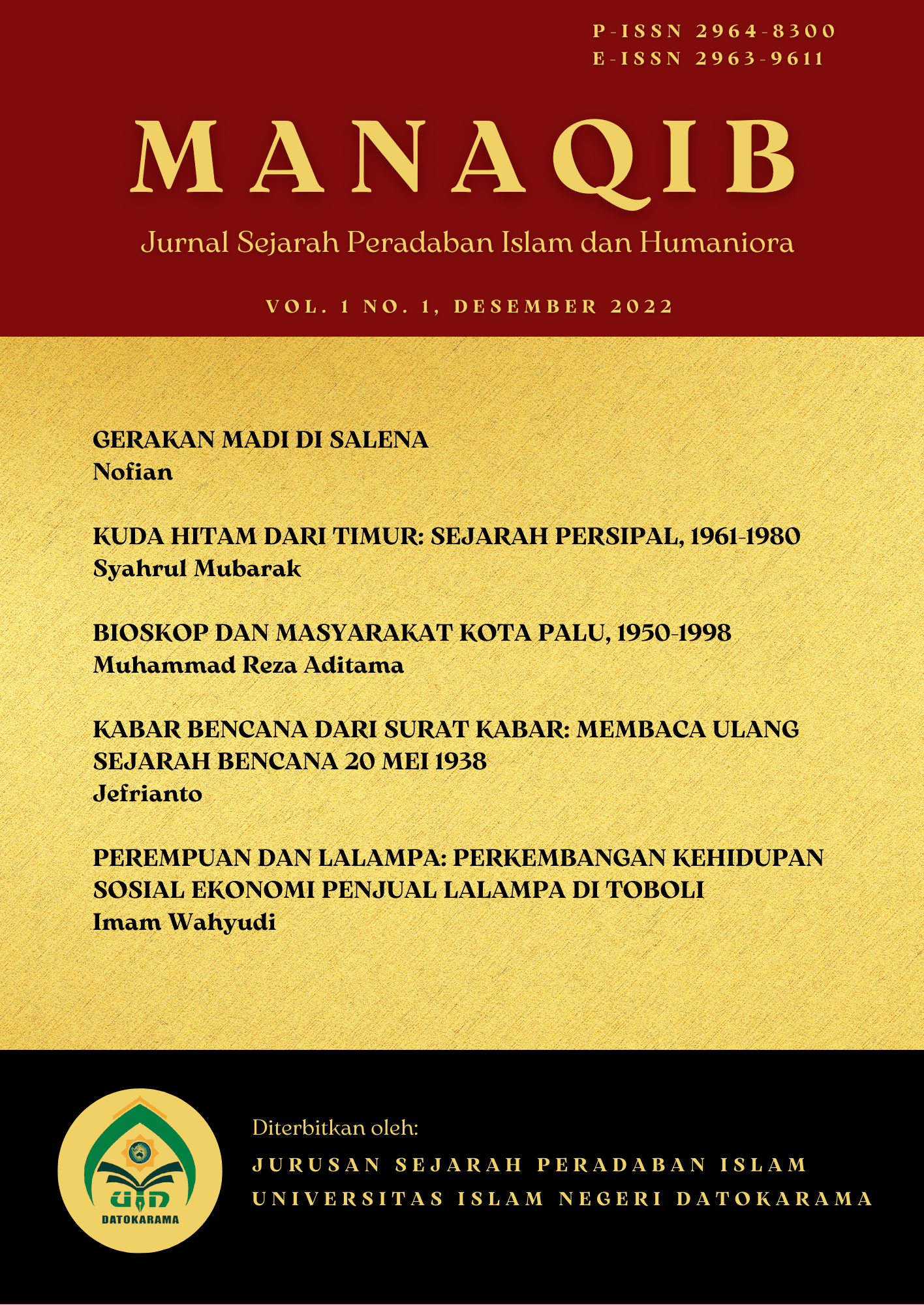BIOSKOP DAN MASYARAKAT KOTA PALU, 1950-1998
Abstract
This article aims to answer the following 3 questions: 1) How is the development of cinema in Palu City?; 2) How is the influence of cinema on the people of Palu City?; and 3) Why does the presence of cinema produce a new cultural identity in the people of Palu City? The problems in this article are solved using historical methodologies and anthropological approaches. The results of this study indicate that: 1) In the period between 1951-1990 the development of cinema was only in the form of an increase in number, then in 1991 there was one cinema that was different from previous cinemas so that it could create a discourse on traditional and modern cinema and the difference was the shape of the building, facilities, and film distribution network. However, without distinguishing between traditional and modern cinemas, all of them stopped operating at the end of 2000 because there were so many alternative media for film screenings; 2) Cinema as popular culture can increase and have an influence on the consumption of fashion, music, and especially films to the behavior of the people in Palu City; 3) Cinema, in the process of presenting a new cultural identity there are several phases in certain periods in society, namely initially only as popular culture (1951–1989), the second learning space (1984–1998), the third non-privacy space (1990–2000), then these three things become markers that cinema, which is only space, can form a new cultural identity in society.
References
Aceng. “Bioskop Di Palu.” Interview by Reza Aditama, October 2, 2020.
Ahmad. “Bioskop Di Palu.” Interview by Reza Aditama, May 29, 2021.
Antariksa. Tuan Tanah Kawin Muda: Hubungan Seni Rupa-LEKRA 1950-1965. Yayasan Seni Cemeti, 2005.
Arifin. “Bioskop Di Palu.” Interview by Reza Aditama, October 13, 2020.
Basundoro, Purnawan. Merebut Ruang Kota: Aksi Rakyat Miskin Kota Surabaya, 1900-1960-An. Tangerang Selatan: Marjin Kiri, 2013.
Bhabha, Homi K. The Location of Culture. London and New York: Rouletdge, 2004.
Budiawan, ed. Ambivalensi. Yogyakarta: Jalasutra, 2010.
Darsun. “Bioskop Di Palu.” Interview by Reza Aditama, November 8, 2020.
Ening. “Bioskop Di Palu.” Interview by Reza Aditama, May 29, 2021.
Heryanto, Ariel. Identity and Pleasure: The Politics of Indonesian Screen Culture. Singapore: NUS Press Pte Ltd, 2014.
Hutari, Fandy. Sandiwara Dan Perang: Propaganda Sandiwara Modern Zaman Jepang. Yogyakarta: Indie Book Corner, 2015.
Inkeles, Alex. “Modernisasi Manusia.” In Modernisasi: Dinamika Pertumbuhan, 87–99. Yogyakarta: Gadjah Mada University Press, 1977.
Khairil. “Bioskop Di Palu.” Interview by Reza Aditama, October 5, 2020.
Liliweri, Alo. Makna Budaya Dalam Komunikasi Antarbudaya. Yogyakarta: Lkis Pelangi Aksara, 2003.
Matt. “Bioskop Di Palu.” Interview by Reza Aditama, September 1, 2020.
Mercusuar. “Cineplex Bioskop Dengan Konsep Manajemen Modern.” Mercusuar, January 3, 1992.
Nainggolan, Nurhayati. Sejarah Daerah Sulawesi Tengah. Jakarta: Departemen Pendidikan dan Kebudayaan, 1984.
Neni. “Bioskop Di Palu.” Interview by Reza Aditama, September 8, 2020.
Nordholt, Henk Schulte. Outward Appearances: Trend, Identitas, Kepentingan. Yogyakarta: LKiS, 2005.
Proyek Inventarisasi dan Dokumentasi Kebudayaan Daerah. Dampak Modernisasi Terhadap Hubungan Kekerabatan Daerah Sulawesi Tengah. Jakarta: Departemen Pendidikan dan Kebudayaan, 1986.
Soekanto, Soerjono. Sosiologi: Suatu Pengantar. Jakarta: Rajawali Press, 2014.




